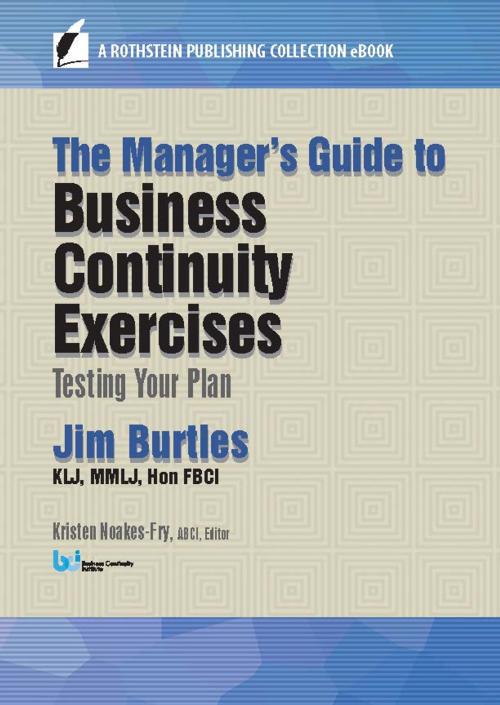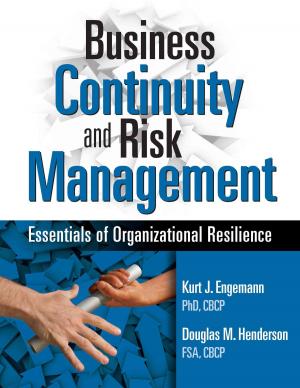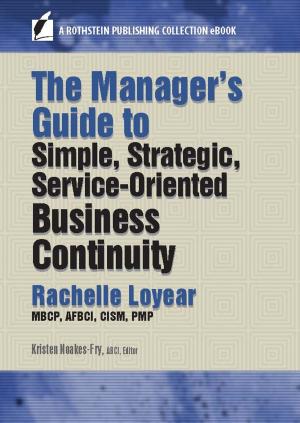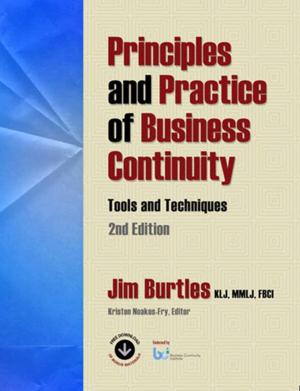The Manager’s Guide to Business Continuity Exercises
Testing Your Plan
Business & Finance, Industries & Professions, Insurance, Management & Leadership, Management| Author: | Jim Burtles, KLJ, MMLJ, Hon FBCI | ISBN: | 9781944480325 |
| Publisher: | Rothstein Publishing | Publication: | October 6, 2016 |
| Imprint: | Rothstein Publishing | Language: | English |
| Author: | Jim Burtles, KLJ, MMLJ, Hon FBCI |
| ISBN: | 9781944480325 |
| Publisher: | Rothstein Publishing |
| Publication: | October 6, 2016 |
| Imprint: | Rothstein Publishing |
| Language: | English |
You designed your Business Continuity Plan to keep your business in business regardless of the forces of man and nature. But how do you know that the plan really works? Few companies can afford the recommended full-scale exercises several times a year. In The Manager’s Guide to Business Continuity Exercises, Jim Burtles, an internationally known expert, details the options for conducting a range of tests and exercises to keep your plan effective and up to date.
Your challenge is to maintain a good and effective plan in the face of changing circumstances and limited budgets. If your situation is like that in most companies, you really cannot depend on the results of last year’s test or exercise of the plan. People tend to forget, lose confidence, lose interest, or even be replaced by other people who were not involved in your original planning. Jim Burtles explains:
“You cannot have any real confidence in your plans and procedures until they have been fully tested…Exercises are the only way we can be sure that the people will be able to interpret the plans and procedures correctly within the requisite timeframe under difficult circumstances.”
As you do your job in this constantly shifting context, Jim Burtles helps you to: • Differentiate between an “exercise” and a “test” – and see the value of each in your BC program. • Understand the different types of plans and identify the people who need to be involved in exercises and tests for each. • Use the “Five-Stage Growth Path” – from desktop to walkthrough to full-scale exercise -- to conduct gradual testing, educate personnel, foster capability, and build confidence. • Create a variety of unusual scenario plot-lines that will keep up everyone’s interest. • Identify the eight main elements in developing and delivering a successful BC exercise. • Select and prepare a “delivery team” and a “response team” for your exercise. • Make sure everyone understands the “rules of engagement.” • Use the lessons learned from exercises and tests to audit, update, and maintain the plan.
You are well aware that a host of problems may crop up in any kind of company-wide project. These problems can range from basic logistics like time and place, to non-support from executives and managers, to absenteeism, to the weather, to participants forgetting their lines. Throughout the book, Burtles uses his decades of experience working with companies like yours to give you useful examples, case studies, and down-to-earth advice to help you handle the unexpected and work toward the results you are looking for.
You designed your Business Continuity Plan to keep your business in business regardless of the forces of man and nature. But how do you know that the plan really works? Few companies can afford the recommended full-scale exercises several times a year. In The Manager’s Guide to Business Continuity Exercises, Jim Burtles, an internationally known expert, details the options for conducting a range of tests and exercises to keep your plan effective and up to date.
Your challenge is to maintain a good and effective plan in the face of changing circumstances and limited budgets. If your situation is like that in most companies, you really cannot depend on the results of last year’s test or exercise of the plan. People tend to forget, lose confidence, lose interest, or even be replaced by other people who were not involved in your original planning. Jim Burtles explains:
“You cannot have any real confidence in your plans and procedures until they have been fully tested…Exercises are the only way we can be sure that the people will be able to interpret the plans and procedures correctly within the requisite timeframe under difficult circumstances.”
As you do your job in this constantly shifting context, Jim Burtles helps you to: • Differentiate between an “exercise” and a “test” – and see the value of each in your BC program. • Understand the different types of plans and identify the people who need to be involved in exercises and tests for each. • Use the “Five-Stage Growth Path” – from desktop to walkthrough to full-scale exercise -- to conduct gradual testing, educate personnel, foster capability, and build confidence. • Create a variety of unusual scenario plot-lines that will keep up everyone’s interest. • Identify the eight main elements in developing and delivering a successful BC exercise. • Select and prepare a “delivery team” and a “response team” for your exercise. • Make sure everyone understands the “rules of engagement.” • Use the lessons learned from exercises and tests to audit, update, and maintain the plan.
You are well aware that a host of problems may crop up in any kind of company-wide project. These problems can range from basic logistics like time and place, to non-support from executives and managers, to absenteeism, to the weather, to participants forgetting their lines. Throughout the book, Burtles uses his decades of experience working with companies like yours to give you useful examples, case studies, and down-to-earth advice to help you handle the unexpected and work toward the results you are looking for.















